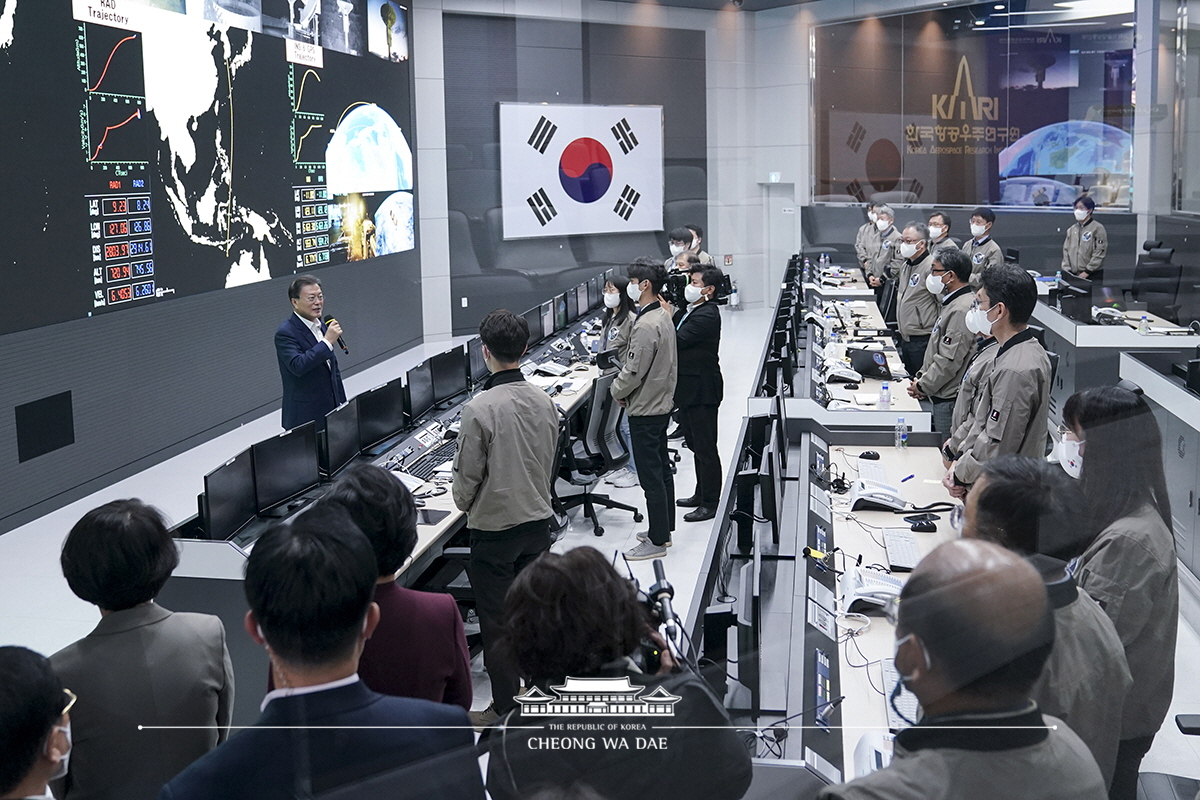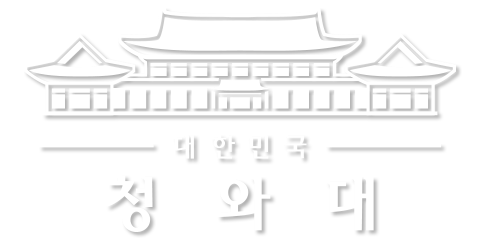이 웹사이트는 제19대 대통령 임기 종료에 따라 대통령기록관이 「대통령기록물 관리에 관한 법률」에 의해 이관받아 서비스하는 대통령기록물입니다. 자료의 열람만 가능하며 수정 · 추가 · 삭제는 불가능합니다.
다만, 「개인정보보호법」에 의하여 개인의 정보를 보호받기 원하시는 분은 관련 내용(요청자, 요청내용, 연락처, 글위치)을 대통령 웹기록물 담당자(044-211-2253)에게 요청해 주시면 신속히 검토하여 조치해 드리겠습니다. 감사합니다.
SPEECHES & REMARKS
BRIEFINGS
Message to Nation from President Moon Jae-in on Launch of Korean Space Launch Vehicle Nuri

Fellow Koreans, space scientists and engineers,
The Nuri flight test has been completed. I am proud of it. It is unfortunate that the launch fell short of perfectly achieving its goal, but – for a first launch – the outcome was remarkable.
From the launch controls, the liftoff, midair ignition of the two-stage rocket engines and their decoupling to the jettisoning of the payload fairing and the separation of the dummy satellite, the flight proceeded in a seamless sequence. Technology that was developed entirely on our own made it all possible. The only task that remains unfinished is placing a dummy satellite safely on an orbit. However, just sending a space launch vehicle 700 km above Earth by itself is an incredible feat, one that brings us closer to outer space.
Twelve years after embarking on a project to develop the Nuri space rocket, we have made it this far. What we need now is one more step forward. Those in the Korea Aerospace Research Institute and academia as well as researchers, workers and business leaders at over 300 domestic businesses have long given their best to research and development. They have shown endurance and an indomitable spirit to take on challenges. I offer all of them my heartfelt respect and encouragement.
If we check and adjust for where we came up short today, we will certainly be able to achieve perfect success in the second launch scheduled for May next year. I hope you will summon a little more strength. Our people will provide unwavering support until the end as well. I am also grateful to the residents of Goheung as well as those from the military and police for their hard work in keeping today's safe launch.
Fellow Koreans,
Space launch vehicle technology is the culmination of both the nation’s scientific and technological capabilities. It has to rely on competence within a wide array of fields, from basic science to a range of engineering – electrical and electronic, mechanical and chemical, optical and material science. Still, there are only six countries that have the ability to put a satellite weighing one ton or more into orbit on their own. As this advanced technology is impenetrably protected by those countries that already possess it, it is very difficult for latecomers to acquire.
We, however, have done just that. We developed high-precision, high-level space launch vehicle technology without anyone else’s assistance. Safer cryogenic oxidizer storage tanks were produced while making their shells as thin as 2.5 mm. The clustering technology needed to make four 75-ton thrusters fire as if they were one single 300-ton rocket engine has also been secured.
The Nuri rocket engines withstood high pressure and stably burned fuel with flames reaching 3,300 degrees centigrade amid an extremely low external temperature of 183 degrees below zero.
Now, it won’t be long before we can carry Korean-made satellites atop domestically developed launch vehicles and place them into precise orbits. The Space Age of the Republic of Korea is now right before our eyes.
Fellow Koreans,
Humankind, from a very long time ago, has gazed at the vast universe and nourished dreams. Imagining space and taking on challenges have become the foundation for scientific development and the advancement of civilizations.
Space development, which has come into full swing since the 1950s, began for the sake of national security and competition between political and economic systems. Today, however, it has become a catalyst for numerous technological innovations that bring changes to our everyday life. Satellites are increasingly used not only for broadcasting, communications and GPS but also for environmental and land management as well as responses to natural disasters and their causes. We are already operating practical satellites that we manufactured on our own, but we had to use other countries’ launch vehicles. If we take yet one more step forward now, we will be able to employ our own launch vehicles to operate numerous satellites.
Now, a “new space” era has dawned across the globe. Over the past decade, the growth of the global space industry has more than doubled, and space development itself has become an industry. Civilian space tourism, which was once like something from a dream, is already actually happening.
Countries at the forefront of space development will take the lead in the future. We’re not behind either. If Nuri’s performance becomes a bit more sophisticated, we will be able to secure our own transport capability in space and usher in the Space Age of the Republic of Korea.
The Government will consistently invest with a long-term perspective, so the Republic of Korea can emerge as a bona fide space powerhouse.
First, we will steadily improve the performance of Korean launch vehicles and use those advances to employ a variety of satellites. By 2027, there will be five more Nuri launches. In May next year, we will meticulously check Nuri’s function once again through a second launch when it will carry a performance verification satellite. Following this, satellites currently under development, including the next-generation small satellite No. 2 and mid-sized satellite No. 3 as well as a cluster of eleven ultra-small satellites, will be sent into space on Nuri missions. Over the next decade, more than 100 satellites will be launched by the public sector alone. To send all of them into space on our own, we will strive to develop various launch vehicles besides Nuri.
Beginning next year, a total of 3.7 trillion won will be injected into a project to develop in earnest the KPS, a Korean global positioning system. It will provide more precise GPS information to the public and serve as a breakthrough in the development of autonomous vehicles, drones and other Fourth Industrial Revolution technologies.
Second, the space industry will surely be turned into a new growth engine after the transfer of related technology to the private sector. With the termination of Korea-U.S. missile guidelines, we are now able to develop a variety of space launch vehicles without restrictions. Solid-fuel launch vehicles are smaller in size than the liquid-fuel ones like Nuri, but they are relatively less expensive to launch. Thus, they will be extensively employed by the private sector as well. By 2024, private-public technical cooperation will be strengthened so that private-sector businesses can develop solid-fuel launch vehicles. A launch site that can be used exclusively by private companies will be built at the Naro Space Center in a bid to foster the space launch service industry. With a new form of space exploration, we will spearhead technological and industrial advancement along with the qualitative growth of the space industry. We will also enter the “new space race” in earnest.
Next month, the status of the chairperson for the Korea National Space Committee will be elevated; the Prime Minister will assume the role instead of the Minister of Science and ICT. By consolidating public- and private-sector capabilities, we will provide policy and institutional support so that world-class space enterprises will be born in Korea as well in the near future.
Third, we will take on challenges more boldly in space exploration projects. We will use our launch vehicles to achieve the dream of landing on the Moon by 2030. From now on, preparations will be made step-by-step. A lunar orbiter will be launched next year. We will also accumulate technology and experience by participating in the Artemis Program, NASA’s first manned lunar exploration project in 50 years.
In 2023, a solar telescope built together with NASA will be installed on the International Space Station. We are also pursuing a plan to explore the asteroid Apophis, which will be nearing Earth in 2029. Through these various projects to explore space, a solid foundation will be established for the space industry and technological development.
Fellow Koreans, space scientists and engineers,
In February, an American Mars rover sent the sound of Martian winds back to Earth. It was a marvelous moment – a gift to all 7.8 billion human beings.
We can do it, too. Though a latecomer, we made an important achievement today. If we extend our vision for space farther, we will be able to stand shoulder to shoulder with the powerhouses of space exploration in the near future. I congratulate you again on today’s success. Let’s move forward with Nuri more vigorously toward the vast universe and a new future.
Thank you.



